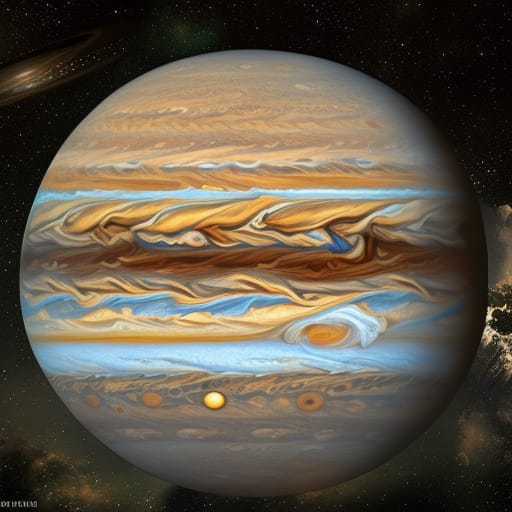Space: Jupiter

Jupiter is the fifth planet from the Sun and the largest in our solar system. Its immense size and unique features make it an important subject of study. Here are the important aspects of Jupiter:
Distance and size: Jupiter is located about 778.3 million kilometers (483.8 million miles) from the Sun. It has a diameter of approximately 139,822 kilometers (86,881 miles), making it more than 11 times wider than Earth.
Composition: Jupiter is a gas giant, composed mainly of hydrogen (about 90%) and helium (about 10%). It lacks a solid surface, and its atmosphere transitions gradually into a dense, metallic hydrogen layer and then into a solid core.
Orbital and rotation period: Jupiter takes approximately 11.9 Earth years to complete one orbit around the Sun. It has the shortest rotation period of any planet in our solar system, with a single rotation taking just under 10 hours. This rapid rotation causes Jupiter to have a slightly oblate shape.
Temperature: Jupiter's upper atmosphere has an average temperature of about -145°C (-234°F). However, the temperature increases with depth, reaching several thousand degrees Celsius in the metallic hydrogen layer and the core.
Surface features: Jupiter's atmosphere is characterized by colorful bands of clouds, including the prominent Great Red Spot, a massive storm system larger than Earth that has persisted for centuries. The planet's cloud bands consist of ammonia ice crystals and are organized by Jupiter's strong zonal winds.
Magnetic field: Jupiter has the strongest magnetic field of any planet in our solar system, generated by the motion of metallic hydrogen in its interior. This magnetic field creates intense radiation belts and a large magnetosphere that extends millions of kilometers into space.
Moons: Jupiter has at least 79 known moons, the four largest of which are the Galilean moons: Io, Europa, Ganymede, and Callisto. These moons were discovered by Galileo Galilei in 1610 and are named in his honor. The Galilean moons are of particular interest for their potential to harbor life, especially Europa, which is believed to have a subsurface ocean of liquid water.
Exploration: Jupiter has been studied by several spacecraft, including flybys by the Pioneer, Voyager, and New Horizons missions. The Galileo spacecraft orbited Jupiter from 1995 to 2003, providing valuable data on the planet and its moons. Currently, NASA's Juno mission is in orbit around Jupiter, studying its atmosphere, magnetic field, and gravitational field.
Observing Jupiter: Jupiter is one of the brightest objects in the night sky and is easily visible with the naked eye. When viewed through a telescope, its cloud bands and Galilean moons become visible.
Mythology: Jupiter is named after the king of the Roman gods and the god of the sky and thunder. In Greek mythology, the planet was associated with Zeus, the king of the gods. The association with the king of the gods is fitting, as Jupiter is the largest and most massive planet in our solar system.